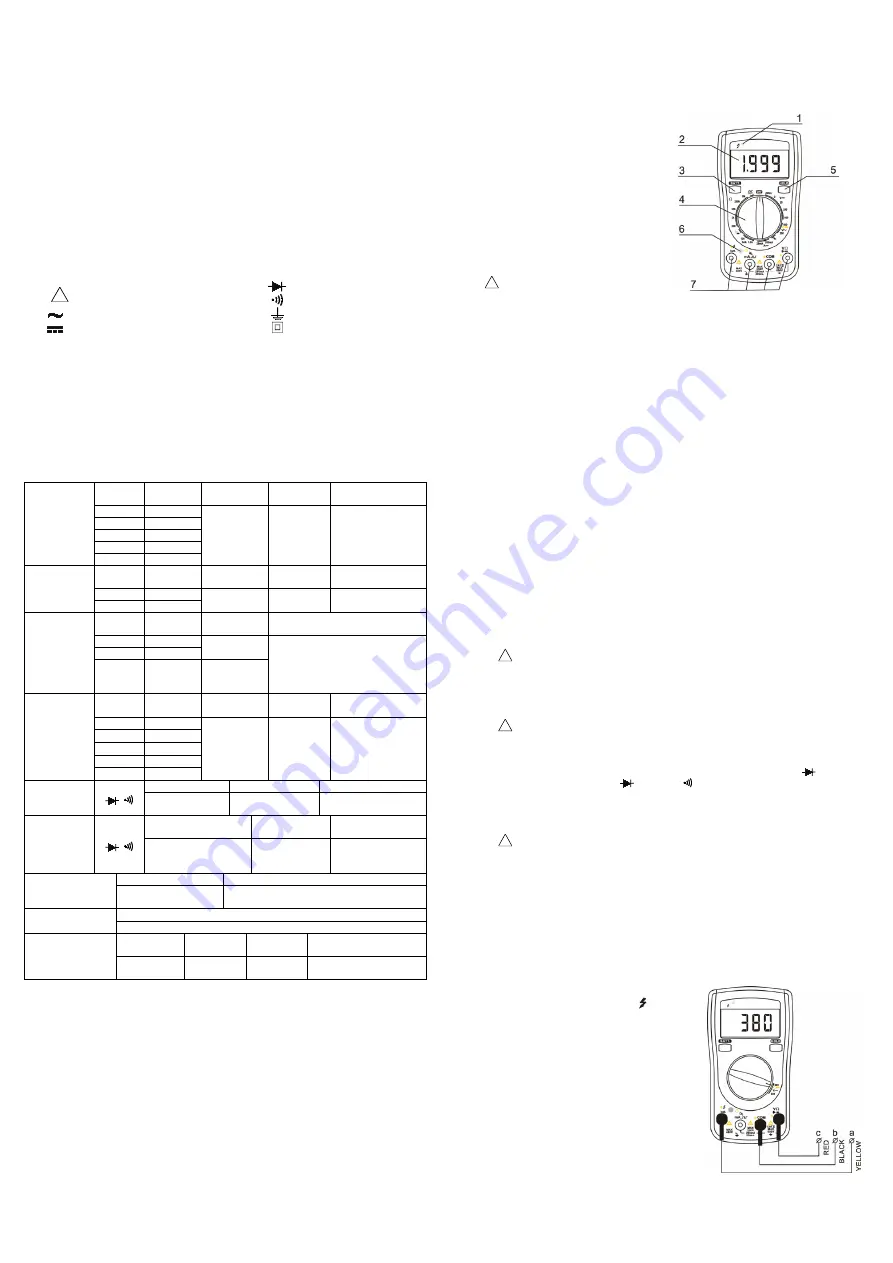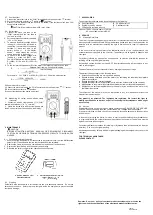
3 1/2 Digits Unbeatable Best Buy Multimeters with All-Ranges Protection
OPERATION MANUAL
1. SAFETY RULES
This meter is designed and tested in accordance with EN publication 61010-1, pollution
degree II and installation category (overvoltage category) II 600V.
This meter has been tested according to the following EC Directives
♦
89/336/EEC Electromagnetic Compatibility, EN61326
♦
73/23/EEC Product safety law of Low Voltage Directive, EN61010-1
This meter is designed to be indoor use at temperature 5
°
C to 40
°
C and altitude up to
2,000m.
To ensure that the meter is used safely, follow all safety and operating instructions in
this operation manual. If the meter is not used as described in this operation manual,
the safety features of this meter might be impaired.
2. INTERNATIONAL SYMBOLS
Important information
Diode
see manual
Continuity
AC
Ground
DC
Double insulation
3. SPECIFICATIONS
3.1 General Specifications
Display
: 3 1/2 digit LCD with max. reading of 1999.
Polarity
: Automatic, (-) negative polarity indication.
Zero adjustment
: Automatic.
Over range indication
: Only the MSD “1” is displayed.
Power
: 1.5V AAA battery x 3
Dimension
: 85 (W) x 155 (H) x 40 (D) mm.
Net Weight
: Approx. 250g. (Including battery).
3.2 Electrical Specifications
Accuracies are
±
(% of r number of least significant digits) at 23
°
C
±
5
°
C, <75% RH.
DC Voltage
Range
Resolution
Accuracy
Input
Impedance
Overload
Protection
200mV
0.1mV
±
(1.0%+3)
10M
Ω
600V DC/ACrms
2V
1mV
20V
0.01V
200V
0.1V
600V
1V
AC Voltage
Range
Resolution
Accuracy
Frequency
(Hz)
Overload
Protection
200V
0.1V
±
(1.2%+3d)
40~400
600V DC/ACrms
600V
1V
DC Current
Range
Resolution
Accuracy
Overload
Protection
20mA
0.01mA
±
(1.2%+3d)
250V DC/ACrms
200mA
0.1mA
10A
(Optional)
*
0.1A
±
(5.0%+3d)
Resistance
Range
Resolution
Accuracy
Open circuit
voltage
Overload
Protection
200
Ω
0.1
Ω
±
(1.2%+3d)
<1.0V
250V DC/AC rms
<30 sec.
2k
Ω
0.001k
Ω
20k
Ω
0.01k
Ω
200k
Ω
0.1k
Ω
2M
Ω
0.001M
Ω
Diode Test
Test Voltage
Test Current
Overload Protection
<3V
Approx. 1.6mA
250V DC/AC rms
<30 sec.
Continuity
Test
Test range
Open circuit
Voltage
Overload
protection
Buzzer sounds when
resistance value
<30
Ω
<3V
250V DC/AC rms
<30 sec.
Phase Sequence
Indication
Range
Phase Sequence Indication
380ACV
±
10%
Correct Phase Sequence
– Phase Sequence Light “ON”
Live Wire
Verification Voltage
Tested Voltage Range
100~250V
Square Waveform
Output
Output
Voltage
Frequency Wave Form
Overload Protection
Approx. 3V
50Hz
Square
Wave
250V DC/AC rms
<30 sec.
4. PANEL DESCRIPTIONS
1.
Live wire verification indication light
2.
LCD display
3.
Battery test key
4.
Multifunction selector
5.
HOLD key
6.
Phase verification indication light
7.
Input terminal
5. OPERATION
!
WARNING
1) When measuring voltage ensure that the
instrument is not connected or switched to a current or resistance, or battery test, or
diode/ continuity check range. Always ensure that the correct terminals are used for the
type of measurement to be made.
2) Use extreme care when measuring voltage above 50V, especially from sources where
high energy exists.
3) Avoid making connections to “live” circuits whenever possible.
4) When performing current measurements ensure that the circuit is not “live” before opening
it in order to connect the test leads.
5) Before performing resistance measurements or diode test, ensure that the circuit under
test is de-energised.
6) Always ensure that the correct function and range is selected. If in doubt about the correct
range, start with the highest and work downwards.
7) Extreme care should be taken when using the instrument to conjunction with a current
transformer connected to the terminals. High voltage may be produced at the terminals if
an open circuit occurs.
8) Ensure that the test leads and prods are in good condition with no damage to the
insulation.
9) Take care not to exceed the overload limits as given in the specifications.
5.1 DC and AC voltage measurement
1. Connect the black test lead to the “COM” terminal and red test lead to the “V” terminal.
2. Set the multifunction selector to desired DC V or AC V position and connect the test leads
across the source or load under measurement.
5.2 DC current measurement
1. Connect the black test lead to the “COM” terminal and red test lead to the “mA” terminal
for measurement up to 200mA.
2. Set the multifunction selector to desired current range position.
3. Connect the test leads in series with the current source to be measured.
4. When the tested current is above 100mA, the input voltage drop might above 1V; hence,
the test duration cannot exceed 15 seconds!
!
CAUTION: Max. input overload: 250V rms < 20sec.
5.3 Resistance measurement
1.
Connect the black test lead to the “COM” terminal and red test lead to the “Ω” terminal.
2. Set the multifunction selector to desired resistance
(Ω) range posi
tion.
3. Connect the test leads across the circuit to be tested.
!
CAUTION: Ensure that the circuit to be tested is “dead”.
Max. input overload : 250V rms < 20sec.
5.4 Diode test
1. Connect the black test lead to the “COM” terminal and red test lead to the “
” terminal.
2. Set the multifunction selector to
(same as ) position.
3. Connect the black and red test leads to the cathode (-) and anode (+) ends of the diode
to be tested respectively.
4. Read the forward voltage drop (junction) value from the display. When the forward biased
is open, the display will shows overload ‘1’ .
!
CAUTION: Max. input overload: 250V rms < 20sec.
5.5 Phase Sequence Verification
1. Connect the red test lead to the “c” terminal, black test lead to “b” terminal and yellow test
lead to “a” terminal
2. Set the multifunction selector to “600V~/abc” range.
3. Connect yellow/black/red test lead to three-phase contact point, If the phase sequence
LED lights on, indicating the connection is in correct phase sequence.
4. If the phase sequence LED lights off, please swap black (b) and red (c) test leads, if the
LED remains off which means that there is a missing phase or wrong connection, please
use Live Wire Verification function to verify each phase again.
5.6 Live Wire Verification
1. Connect the red test lead to the “ ” terminal,
black test lead to “COM” terminal and hold the black
test lead (please note:
do not touch the test pin
and keep your hands away from the finger guard
of the test lead!
)
2. Set the multifunction selector to “600V~/abc”
range.
3. Use the red test lead to contact the live wire to
be tested. When there is a live wire, the Live Wire
Verification lights will turn on.
!


